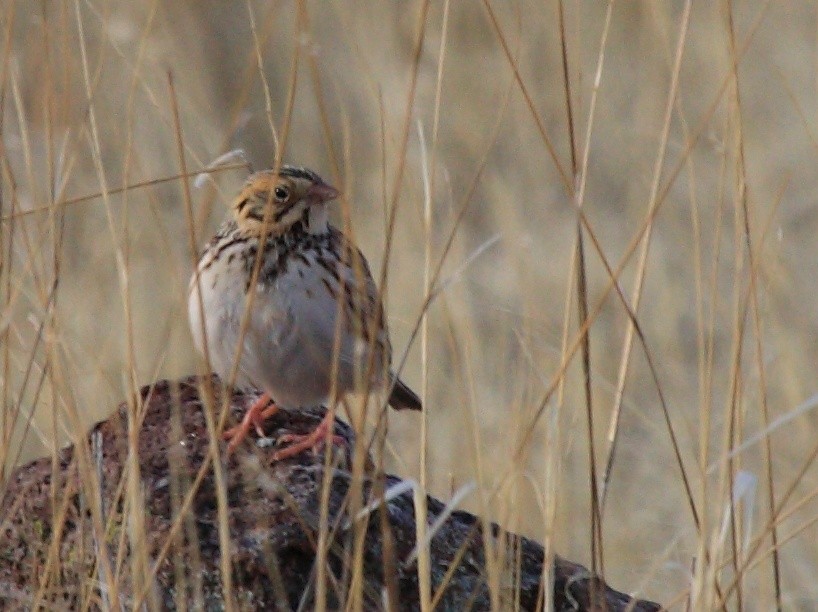Baird's Sparrow
A species of Grassland sparrows Scientific name : Centronyx bairdii Genus : Grassland sparrows
Baird's Sparrow, A species of Grassland sparrows
Botanical name: Centronyx bairdii
Genus: Grassland sparrows
Content
Description General Info
 Photo By Dominic Sherony , used under CC-BY-SA-2.0 /Cropped and compressed from original
Photo By Dominic Sherony , used under CC-BY-SA-2.0 /Cropped and compressed from original Description
The Baird's sparrow can be identified as a small brown streaked sparrow. Their faces are a yellow-brown color featuring subtle black markings. These birds have a narrow band of brown streaks on their chests. This species can be distinguished from others by its unique broad ochre central crown stripe. Juveniles exhibit similar coloration but often have more streaking. Adult size is comparable for both males and females, no sexual dimorphism is exhibited. Adults are generally about 12 cm (5") and weigh 17-21 g (½ to ¾ oz); their wingspan is usually around 23 cm (9"). They are larger than Le Conte's sparrow and do not exhibit orange coloration on their faces. They exhibit very similar coloration and patterning to Henslow's sparrow but do not have green coloration on their faces. The Savannah sparrow is more heavily streaked and has an extra white marking on its head. 
Size
14 cm
Life Expectancy
Baird's sparrows nest on the ground in either depressions or tufts of grass. These nests are usually made out of grass and consist of two layers, with finer material on the inside. These birds nest in small loose colonies. A normal clutch size is usually two to six white-gray eggs with brown spots. These birds are altricial, and rely on parental care for survival after hatching. 
Nest Placement
Ground
Clutch Size
4 - 5 eggs
Incubation Period
1 - 2 broods
Number of Broods
11 - 12 days
Nestling Period
8 - 11 days
Feeding Habits
Baird's Sparrow's diet consists mainly of insects and seeds foraged on the ground, including beetles, grasshoppers, caterpillars, leafhoppers, flies, and spiders. They exhibit ground feeding behaviors, picking up these prey along with grass seeds.
Habitat
Baird's Sparrow are typically found in expansive native grasslands such as tallgrass and mixed grass prairies, often at moderate altitudes. They prefer environments with undisturbed vegetation, avoiding wooded areas and cultivated lands. These conditions offer the specific climate, altitude, and vegetation types, such as fescue, necessary for their survival. During winter, baird's Sparrow inhabit grasslands with occasional shrubs in northern Mexico and the southern United States. Migration habits are less understood, but they appear to favor weedy fields and hayfields with native grasses.
Nest Behavior
Baird's Sparrow starts building their nest during breeding season. The female, with possible male help, constructs the nest. The timing of egg-laying and the extent of parental care after hatching are typical of small passerines, with both parents involved.
Nest Characteristics
Baird's Sparrow's nest is ground-based, often in a depression or hoofprint by grass clumps. It features two layers: an outer part of grass/stems and an inner section with fine grasses, occasionally with fur. The nest measures about 2.5 inches across and 2 inches deep.
Dite type
Insectivorous
General Info
Feeding Habits
Bird food type
Behavior
Baird's Sparrow exhibits distinctive terrestrial habits, primarily foraging on the ground within grasslands. Males characteristically perch on high points to vocally claim their territory, predominantly during breeding periods. While avoiding threats, baird's Sparrow favors running through grasses over flight. This species practices seasonal monogamy, forming dense breeding clusters, while remaining tolerant of non-competitive sympatric avifauna. Territorial defense is typical against intraspecific encroachment. On wintering grounds, baird's Sparrow's behavior is less understood, yet indications of stable home ranges have been observed in repeated seasonal captures.
Distribution Area
The Baird's sparrow migrates from its summer breeding habitat, the tall grass prairies of north central United States and South Central Canada, to spend winters in northern Mexico and the southern tip of the United States near Texas. Due to this migratory behavior, they may be spotted all across the Midwest portion of the United States during migratory seasons, but most frequently can be found in North Dakota, South Dakota, Minnesota, Montana, and Canada during the summer. This species of sparrow resides in grassland habitats. These birds rely on the (now diminishing) tallgrass prairies, mixed grass prairies, and moister fescue prairies of northern United States and southern Canada. The dwindling status of this habitat puts many animals whose lifestyles rely on these ecosystems in peril. Land featuring woody vegetation and cultivated land is generally not a suitable environment for Baird's sparrows to thrive in. 
Species Status
There is some concern about the conservation status of Baird's sparrows; their numbers are reduced compared to historic numbers. This species is listed under the IUCN Red List under the category of "least concern". Maintaining the original habitat is important for this species because artificial habitat recreation is not suitable for these birds. Fragmentation can lead to adverse conditions for Baird's sparrows, including increased nest parasitism. 
Scientific Classification
Phylum
Chordates Class
Birds Order
Perching birds Family
New world sparrows Genus
Grassland sparrows Species
Baird's Sparrow